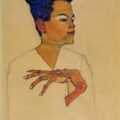The Poetics of Gender Resistance
The passion for setting people right is in itself an afflictive disease.
Distaste which takes no credit to itself is best.

Women Write Resistance: Poets Resist Gender Violence
edited by Laura Madeline Wiseman
Softcover, 19.95
Hyacinth Girl Press, 2013
These concluding lines from Marianne Moore’s “Snakes, Mongooses, Snake-Charmers, and the Life” are good advice from one of our best high modern poets. But it is advice that’s hard to follow in cases of bodily or emotional harm when the need to speak out can be compelling, and must be honored. It can be especially hard when encountering an A to Z of heart-rending gender violence—as in the new anthology Women Write Resistance—of child abuse, false imprisonment, incest, jealousy, murder, oppression, rape. Throughout this book, women speak to women, in sympathy and in exasperation to themselves and each other. I like the way Rebecca Foust sustains a family quarrel in her poem “Backwoods”:
[…] would you really go back
to that tarpaper shack squatting
in bottles and weeds,where your beloved canoe still lies on its side
split like your lip
where he kicked it
The quarrel, between the poet tied to a “he” in a situation of powerlessness and humiliation, and the literate self, is enacted again and again in this volume. I like the sassy tone in which political poet Andrena Zawinski writes, “Some women take it flat on / their backs, slapped in a cast, choked // […] Some women / want a revolution like a lover / and a full metal jacket for a heart.” Grace Bauer is one poet who rightly asks: “Why did you stay with him? Why did you allow it to happen?” In her poem “Common Law”, she movingly provides the answers so many women know:
Because he wasn’t always bad.
Then because he was all you had.
. . .
Because he said he’d kill you if you ever tried to leave.
Because you had nowhere to go
or didn’t know how to get there.
“How did you allow it to happen?” is a question we as a culture are still struggling to answer. Surely “he” wasn’t always everything in your life. When and how does a person give up friends, co-workers, family; how can that person still own their situation, how can they begin to be a responsible adult again? These are the important and complicated questions addressed and crystallized by the poets of this anthology.
The simplicity of presentation in many of these poems is appealing. Often they rely on simple statements, the type that victims themselves might have used. Lucy Adkins, for example, writes in “Grandma Ellen Tells It Like It Was”:
There is no disgrace
in sleeping with the enemy.
You did it for the children.
You did it to survive.
Insights like these first began entering the general consciousness 30 or 40 years ago, in the period of second-wave feminism. No doubt there are those who would rather not hear them again. If so, this volume is not for them. But there are those who need to learn to speak out, and these poems are a reminder that there are ways to do that, and there are people who will listen and read.
The need to explain, to seek reasonable understanding—as in the poems cited above—can yet occlude the reader’s experience from time to time. Adkins’ and Bauer’s crisp lines distill a life’s experience rather than bring it to life. To paraphrase Adrienne Rich’s “Tonight No Poetry Will Serve,” the verbs—in this case, to slap, punch, or threaten to kill—pilot the plane, but they are flying high, far from the actual terrain. The subjects of the texts—the wife, the wife-beater, the mother, the boyfriend—are submerged in the language used to describe them. But these schematic poems do provide the skeletal structure of understanding, and though they may lack the tingling of flesh, they may provide an essential, hidden form for standing erect and moving forward.
Sometimes offering the direct experience, sometimes not, drawing on history, myth, and pictorial representations, all the poems collected by editor Laura Madeline Wiseman excoriate the sources of depressions and mental illnesses, fears, passivity, the inclination to revenge and suicide. Underplayed, however, are women’s experiences of strengthening themselves to prevent assault; missing are the processes by which the vulnerable of either gender become less so. Lacking entirely is an understanding that excoriation is not a particularly effective tool for changing the people and the conditions that result in domestic violence. But there can be no doubt that the anthology reminds us of unnecessary suffering and provides a vital platform for speaking out.
If the enumeration of violations can have power, as in Zawinski’s “Some Women, Take Heart,” then narratives, like Jennifer Perrine’s “After He Breaks Her Arm,” bring us closer to a lived experience. Perrine’s persona is a caring, likeable woman who tenderly looks after her friend when the friend has been severely beaten.
[. . .] I wake her with tea,
burnt toast, runny eggs, though she winces
when she chews, the black whorl on her jaw
now haloed in green. Until her right eye
opens, I read her books, whatever’s handy,whatever keeps her here. […]The eighth night,
when she tells me she misses him, I’m kneeling
in the bethel of the bathroom, bent overthe rub, raking a razor through the thick
lather on her legs, and when she says,
take me home, I nick her ankle just enoughto draw blood, one rusty drop [ . . .]
Perrine captures the victim’s passivity, collapse and susceptibility to coddling—her porous soma and bodily postures; here the poet might have explored the delicate, shifting terrain of bodily forms. Instead she focuses on the narrating caregiver’s enmeshment—the blurred boundaries that often lead to abuse. The poem’s surface details carry us swiftly forward without wholly preparing us for the end of the poem.
The voices or personae in many of these poems are young, like the fifteen year old in Jill Khoury’s “Home Security” who remembers her “first thief”:
He didn’t have to hold me down. Tell me you like it or I’ll make you bleed.
I’ll make your mother bleed.
My own codes and sequences a mystery to me.
The poet’s quarrel with herself becomes a baffled utterance. Kerri French speaks through Frankie Silver, who killed her abusive husband: “The wind knows my reasons.” Lisa Lewis reveals her visceral response to a man sitting next to the woman he has clearly beaten. For her own murderous thoughts, she acknowledges, “I am not sorry. I might have killed/ That man.” At times, the poems seem to burst forth out of a long silence. In Gail Ghai, “Foundation,” for example, women are “always falling / out of themselves/ like shooting stars/ that explode/ in a shower / of hot white pain.”
This is not a volume that’s easily read. Its intensity required of me several breaks from the angry quarrels, the details of the violence. It was painful to be reminded that the assaulters must be named, and healing and personal re-formation can take years. Thus, long after the fact of her father’s death, the Dutch-born Californian Laure-Anne Bosselaar addresses her father’s body in the morgue in “The Cellar,”
[…] And I see hisrage down there, dark—like a fist
crammed between his legs. I touch his hands, the huge
Dutch hands that almost killed me, almost killed
my daughter […]
The characters depicted here are both vivid and loathsome. The poem is intensely powerful: a male body experienced by Bosselaar as a field where explosives lie undetected, waiting for the unsuspecting child to trespass. Kristy Bowen, on the other hand, bursts into sarcastic, brusque, vigorous speech in “No Girls Were Harmed in the Making of This Poem.” These first-hand eruptions by Bowen and others were among the most powerful poems in this anthology, unexpectedly so. (In retrospect, I was surprised to see the editor had not included San Francisco poet Sharon Doubiago.)
Interesting, but ultimately less moving, are the poems drawn straight from history. Yet history is what first drew Wiseman to this topic: when she became aware of the hundreds of women murdered in Juarez, Mexico, and began writing about them. Some of the poems Wiseman went on to select for this anthology are suffused with the historical—actual events, a poet’s biography, or recollections from the deep trove of shared history. When, for example, the murder of teenage lesbians in a Texas park is reported in the newspaper, the poet Meg Day elegizes,
each grave you chose for burying your rage
alongside our bodies, still intertwined
Leslie Adrienne Miller reaches back to the 1828 West Port Murders in Edinburgh, when a dead body, however obtained, brought a few pence from the doctor in charge of the dissecting room at the medical school. A shared past can be approached through everyday life or through the grandeur of myth. Tyler Mills recalls Philomela, whose tongue is cut out by the King when he is done with her. Intertwining gender violence with Western mythology in “The Cost of Dark II,” Janice Moore Fuller uses the religious unification of God-the-father and God-the son to create a vivid portrait of a parent whose lack of adult identity and inability to draw boundaries leads, disturbingly, to incest.
The responses to violence collected here are varied and multidimensional. Therese Halscheid, in “Song, As a Solution,” recounts how the women in South Africa gather together to sing about an abusive husband, until he finally changes his ways.
They sing
where he is
slashing to bring down the husks
and continue even while fists of sun
light
beat
about
until a blushed shade of dusk brings him homeward
in shame.
The experimental poems of Jehanne Dubrow, Hadara Bar-Nadav, and Evie Shockley offer insight into the subjective experience with their disjunctive imagery of brokenness. The open form found in most of the poems in this volume is modulated by Bar-Nadav in “Lust and Smoke” to a five stanzas that opens with the metaphor of a woman’s dress voluminous and sensuous as a tent, evoking the plains of Mamre where ancient Israelites like Abram pitched their tents.
How to compete with a tent so big?
Your dress hung from a tree,
your dress waving from a tower
and then your dress breathtaking on TV,
The reporter bleeding from her mouth.
All the people line up so see you
radiant in firelight, with shreds
of cotton in their fists
and their fists in their mouths.The smoke is thick inside this tent
and you, volcanic, spread.
Velvet ash, velvet wish.
Soon we are crawling. We are dead.
Despite the violent material, as readers we recognize Bar-Nadav’s foraged links to literary and biblical traditions here. The violence is collective, rather than strictly domestic, but she stays close to the interrupted nature of experience: sensory impressions flit in and out of the mind, curiously disjoined from action or conscience or even full consciousness.
Jehanne Dubrow, like Nadav, strays from straightforward narrative in her poem “Schiller,” capturing the victim’s terror and the ways that terror disorders thought, evoked in the repetitions and inversions of phrases like “In a place called home” to “In a place called knife” to “In a place called man” and in the staccato repetitions of “the knife” to capture the victim’s terror: “The man with the knife is capable of/ sublimity. The man with the knife is /capable. The man is capable of holding her / in place. He holds her in a place called / home. In a place called home, a man with a / knife. In a place called knife, a man.”
Evie Shockley has the only concrete poem in this collection. In “At the Musée de l’Homme,” a catalog of abuses of women is shaped as a perfect circle. This poem embodies what a poetic rant or political tirade cannot—what I call the geometry of resistance, the bodily form of a person determined to withstand and resist the onslaught of abuse: first, by seeing it coming; second, by removing herself from the scene. For women who have been susceptible to abuse, this bodily form can only be achieved by long, steady, inner work, to which a call to arms can only be a distraction. Shockley does not directly call women to this inner work—that is perhaps the subject of another anthology—but she powerfully shapes it in her mimetic form. Memory is not directed outward but shaped as a protective shield, to gird the inner life against any further harm.
About Zara Raab
Zara Raab's most recent books are Rumpelstiltskin, or What's in a Name? (Finishing Line Press) and Fracas & Asylum (David Robert Books, 2013). She lives in western Massachusetts. Visit her at http://www.zararaab.com.





